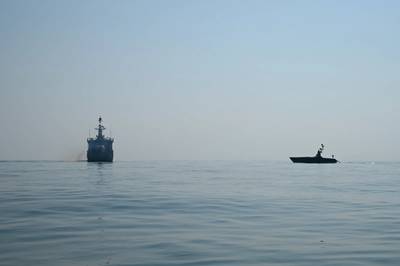Uncrewed Boats Are Changing the Way Wars Are Fought at Sea
When Ukraine successfully deployed self-driving “drone” boats for a major attack on the Russian navy at Sevastopol in Crimea in September 2022 it was a defining moment that changed the future of naval warfare. Uncrewed surface vessels (USVs) have been used before, but this was the first instance of multiple, armed USVs, used simultaneously in combination with aerial drones for a successful, offensive naval operation on a military target.
Several Russian ships were damaged in the attack, and the USVs were reportedly able to penetrate the harbor defenses and cause damage to ships in protected anchorages. This will cause a rethink of the role of uncrewed vessels for offensive naval ops, and of harbor defenses to protect against such attacks.
USVs offer a number of advantages over regular manned vessels which make them attractive to navies – and many countries have been developing or experimenting with them in recent years. The US has invested heavily with a strategic plan to acquire medium, large and extra-large “unmanned vehicles” to operate both on the surface and underwater. By 2052, more than half of the US naval fleet could potentially be uncrewed.
Other navies are reluctant to be left behind and are actively developing their uncrewed and autonomous capabilities. These include China, UK, South Korea, Japan, Singapore, Australia, and others.
By removing human crews from naval vessels a number of efficiencies can be achieved. The design of the ship can be streamlined, disregarding human needs such as sleeping, eating and safety (sleeping berths, galleys, life-rafts and life-jackets can all be removed). So they can be smaller, cheaper to run, faster and able to remain at sea for longer periods of time, in harsher conditions, without any risk of injury or human error.
If armed, they are able to strike targets at the push of a button. And if armed with artificial intelligence (AI) enabled weapons, they are able to identify, acquire and engage targets without any human oversight – and at much greater speeds. Vice-admiral Roy Kitchener, the commander of US naval surface forces, commented in December 2022 that USVs would be a “catalyst for innovation” in the US Pacific fleet, adding that: “The implementation of unmanned systems will increase decision speed and lethality to enhance our warfighting advantage.”
Ethical and legal questions
But the use of these uncrewed warships raises a number of important legal and ethical questions. Under the United Nations Convention on the Law of the Sea (UNCLOS) – often referred to as the “Constitution of the Oceans” – a “warship” is legally defined as being “under the command of an officer” and “manned by a crew which is under regular armed forces discipline” (emphasis added).
As the “Articles to the Law of the Sea with Commentaries” from 1956 explains, “the definition of the term ‘warship’ has been based on articles 3 and 4 of The Hague Convention of 18 October 1907 relating to the conversion of merchant ships into warships”. The purpose of Article 29 was not to ensure the presence of human crews on warships. That was assumed. It was actually directed at ensuring crews of naval vessels were subject to state oversight and military discipline in response to the practice of privateering which had been employed by some states.
At present there is no settled legal position on the status of uncrewed vessels as “warships”. So how different states use them will be instrumental in forming a more solid position in international law.
Arguably, an expansive, evolutionary approach to interpreting the convention in light of modern advancements, and the purpose of Article 29, could allow an uncrewed vessel to be regarded as a “warship” to ensure a state’s accountability for its actions. This is precisely the view taken by the UK Ministry of Defense in a submission to the House of Lords in November 2021. On the question of whether UNCLOS is “fit for purpose” in the 21st century, it said that Article 29 confirms that:
- "State responsibility for the actions of warships and requires that the state have an accountable system of discipline to control the actions of those who operate them. Uncrewed vessels should be incorporated into this regime to regulate their proper use. This would be best achieved by an acceptance that Article 29 applies to state operated military uncrewed vessels."
The House of Lords, in its report on UNCLOS: the law of the sea in the 21st century, noted the “absence of international regulation” on the question of “whether maritime autonomous vehicles can be classified as warships or not” and the need to “work with like-minded partners to regulate these technologies”. Effectively leaving the question open until further international practice, opinion and consensus builds up.
The rapidly evolving technology means that the pace of naval conflict will continue to increase. Swarms of networked drones, equipped with AI will give significant speed and lethal advantages to those forces that use them. This will make human “in-the-loop” decision-making increasingly redundant – and even disadvantageous in future conflicts.
But there are significant cyber-security concerns and questions about the reliability and timeliness of human oversight of autonomous systems operating hundreds of nautical miles – possibly underwater – away from human oversight or control. Further, the UK’s commitment to the ethical and legal use of autonomous systems does in no way guarantee that rivals, enemies, or even allies, will show the same restraint – especially in times of war.
The international debate over lethal autonomous weapons systems (LAWS) and calls for a convention to ban them are relevant in this context. An issue of this importance needs to be subject to a public debate and parliament, as a representative of the people, needs to determine their legality and use.
The author
Adam James Fenton, Associate Professor (Research), Coventry University
(Source: The Conversation)














